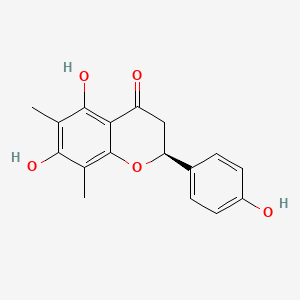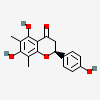(S)-2,3-dihydro-5,7-dihydroxy-2-(4-hydroxyphenyl)-6,8-dimethyl-4-benzopyrone
PubChem CID
442396
Molecular Formula
Synonyms
- Farrerol
- CHEBI:67897
- CHEMBL507611
- (2S)-5,7-dihydroxy-2-(4-hydroxyphenyl)-6,8-dimethyl-2,3-dihydrochromen-4-one
- (S)-2,3-Dihydro-5,7-dihydroxy-2-(4-hydroxyphenyl)-6,8-dimethyl-4-benzopyrone
Molecular Weight
300.30 g/mol
Computed by PubChem 2.2 (PubChem release 2021.10.14)
Dates
- Create:2005-06-24
- Modify:2025-01-18
Description
Farrerol is an organic molecular entity. It has a role as a metabolite.
(S)-2,3-Dihydro-5,7-dihydroxy-2-(4-hydroxyphenyl)-6,8-dimethyl-4-benzopyrone has been reported in Rhododendron dauricum, Pancratium maritimum, and other organisms with data available.
Chemical Structure Depiction

(2S)-5,7-dihydroxy-2-(4-hydroxyphenyl)-6,8-dimethyl-2,3-dihydrochromen-4-one
Computed by Lexichem TK 2.7.0 (PubChem release 2021.10.14)
InChI=1S/C17H16O5/c1-8-15(20)9(2)17-14(16(8)21)12(19)7-13(22-17)10-3-5-11(18)6-4-10/h3-6,13,18,20-21H,7H2,1-2H3/t13-/m0/s1
Computed by InChI 1.0.6 (PubChem release 2021.10.14)
DYHOLQACRGJEHX-ZDUSSCGKSA-N
Computed by InChI 1.0.6 (PubChem release 2021.10.14)
CC1=C(C(=C2C(=C1O)C(=O)C[C@H](O2)C3=CC=C(C=C3)O)C)O
Computed by OEChem 2.3.0 (PubChem release 2024.12.12)
C17H16O5
Computed by PubChem 2.2 (PubChem release 2021.10.14)
farrerol
- Farrerol
- CHEBI:67897
- CHEMBL507611
- (2S)-5,7-dihydroxy-2-(4-hydroxyphenyl)-6,8-dimethyl-2,3-dihydrochromen-4-one
- (S)-2,3-Dihydro-5,7-dihydroxy-2-(4-hydroxyphenyl)-6,8-dimethyl-4-benzopyrone
- (S)-5,7-Dihydroxy-2-(4-hydroxyphenyl)-6,8-dimethylchroman-4-one
- (2~{S})-2-(4-hydroxyphenyl)-6,8-dimethyl-5,7-bis(oxidanyl)-2,3-dihydrochromen-4-one
- AC1L9CQK
- Farrerol, >=98% (HPLC)
- DTXSID40947026
- DYHOLQACRGJEHX-ZDUSSCGKSA-N
- HY-N0344
- s9552
- ZINC04098306
- AKOS015896732
- AC-34143
- CS-0008902
- C09734
- Q27104948
- (2S)-5,7-dihydroxy-2-(4-hydroxyphenyl)-6,8-dimethyl-chroman-4-one
- 5,7-Dihydroxy-2-(4-hydroxyphenyl)-6,8-dimethyl-2,3-dihydro-4H-1-benzopyran-4-one
- JXY
Property Name
Property Value
Reference
Property Name
Molecular Weight
Property Value
300.30 g/mol
Reference
Computed by PubChem 2.2 (PubChem release 2021.10.14)
Property Name
XLogP3-AA
Property Value
3.1
Reference
Computed by XLogP3 3.0 (PubChem release 2021.10.14)
Property Name
Hydrogen Bond Donor Count
Property Value
3
Reference
Computed by Cactvs 3.4.8.18 (PubChem release 2021.10.14)
Property Name
Hydrogen Bond Acceptor Count
Property Value
5
Reference
Computed by Cactvs 3.4.8.18 (PubChem release 2021.10.14)
Property Name
Rotatable Bond Count
Property Value
1
Reference
Computed by Cactvs 3.4.8.18 (PubChem release 2021.10.14)
Property Name
Exact Mass
Property Value
300.09977361 Da
Reference
Computed by PubChem 2.2 (PubChem release 2021.10.14)
Property Name
Monoisotopic Mass
Property Value
300.09977361 Da
Reference
Computed by PubChem 2.2 (PubChem release 2021.10.14)
Property Name
Topological Polar Surface Area
Property Value
87 Ų
Reference
Computed by Cactvs 3.4.8.18 (PubChem release 2021.10.14)
Property Name
Heavy Atom Count
Property Value
22
Reference
Computed by PubChem
Property Name
Formal Charge
Property Value
0
Reference
Computed by PubChem
Property Name
Complexity
Property Value
417
Reference
Computed by Cactvs 3.4.8.18 (PubChem release 2021.10.14)
Property Name
Isotope Atom Count
Property Value
0
Reference
Computed by PubChem
Property Name
Defined Atom Stereocenter Count
Property Value
1
Reference
Computed by PubChem
Property Name
Undefined Atom Stereocenter Count
Property Value
0
Reference
Computed by PubChem
Property Name
Defined Bond Stereocenter Count
Property Value
0
Reference
Computed by PubChem
Property Name
Undefined Bond Stereocenter Count
Property Value
0
Reference
Computed by PubChem
Property Name
Covalently-Bonded Unit Count
Property Value
1
Reference
Computed by PubChem
Property Name
Compound Is Canonicalized
Property Value
Yes
Reference
Computed by PubChem (release 2021.10.14)
Potential endocrine disrupting compound
S109 | PARCEDC | List of 7074 potential endocrine disrupting compounds (EDCs) by PARC T4.2 | DOI:10.5281/zenodo.10944198
Polyketides [PK] -> Flavonoids [PK12] -> Flavanones [PK1214]
Follow these links to do a live 2D search or do a live 3D search for this compound, sorted by annotation score. This section is deprecated (see here for details), but these live search links provide equivalent functionality to the table that was previously shown here.
Same Connectivity Count
Same Parent, Connectivity Count
Similar Compounds (2D)
Similar Conformers (3D)
Same Count
Protein Structures Count
The LOTUS Initiative for Open Natural Products Research: frozen dataset union wikidata (with metadata) | DOI:10.5281/zenodo.5794106
- CAS Common ChemistryLICENSEThe data from CAS Common Chemistry is provided under a CC-BY-NC 4.0 license, unless otherwise stated.https://creativecommons.org/licenses/by-nc/4.0/
- EPA DSSTox5,7-Dihydroxy-2-(4-hydroxyphenyl)-6,8-dimethyl-2,3-dihydro-4H-1-benzopyran-4-onehttps://comptox.epa.gov/dashboard/DTXSID40947026CompTox Chemicals Dashboard Chemical Listshttps://comptox.epa.gov/dashboard/chemical-lists/
- European Chemicals Agency (ECHA)LICENSEUse of the information, documents and data from the ECHA website is subject to the terms and conditions of this Legal Notice, and subject to other binding limitations provided for under applicable law, the information, documents and data made available on the ECHA website may be reproduced, distributed and/or used, totally or in part, for non-commercial purposes provided that ECHA is acknowledged as the source: "Source: European Chemicals Agency, http://echa.europa.eu/". Such acknowledgement must be included in each copy of the material. ECHA permits and encourages organisations and individuals to create links to the ECHA website under the following cumulative conditions: Links can only be made to webpages that provide a link to the Legal Notice page.https://echa.europa.eu/web/guest/legal-notice(S)-2,3-dihydro-5,7-dihydroxy-2-(4-hydroxyphenyl)-6,8-dimethyl-4-benzopyronehttps://echa.europa.eu/substance-information/-/substanceinfo/100.041.877
- ChEBI
- LOTUS - the natural products occurrence databaseLICENSEThe code for LOTUS is released under the GNU General Public License v3.0.https://lotus.nprod.net/(S)-2,3-Dihydro-5,7-dihydroxy-2-(4-hydroxyphenyl)-6,8-dimethyl-4-benzopyronehttps://www.wikidata.org/wiki/Q27104948LOTUS Treehttps://lotus.naturalproducts.net/
- ChEMBLLICENSEAccess to the web interface of ChEMBL is made under the EBI's Terms of Use (http://www.ebi.ac.uk/Information/termsofuse.html). The ChEMBL data is made available on a Creative Commons Attribution-Share Alike 3.0 Unported License (http://creativecommons.org/licenses/by-sa/3.0/).http://www.ebi.ac.uk/Information/termsofuse.htmlChEMBL Protein Target Treehttps://www.ebi.ac.uk/chembl/g/#browse/targets
- Japan Chemical Substance Dictionary (Nikkaji)
- KEGGLICENSEAcademic users may freely use the KEGG website. Non-academic use of KEGG generally requires a commercial licensehttps://www.kegg.jp/kegg/legal.htmlPhytochemical compoundshttp://www.genome.jp/kegg-bin/get_htext?br08003.keg
- LIPID MAPSLipid Classificationhttps://www.lipidmaps.org/
- Natural Product Activity and Species Source (NPASS)
- Metabolomics Workbench
- NORMAN Suspect List ExchangeLICENSEData: CC-BY 4.0; Code (hosted by ECI, LCSB): Artistic-2.0https://creativecommons.org/licenses/by/4.0/NORMAN Suspect List Exchange Classificationhttps://www.norman-network.com/nds/SLE/
- Protein Data Bank in Europe (PDBe)
- RCSB Protein Data Bank (RCSB PDB)LICENSEData files contained in the PDB archive (ftp://ftp.wwpdb.org) are free of all copyright restrictions and made fully and freely available for both non-commercial and commercial use. Users of the data should attribute the original authors of that structural data.https://www.rcsb.org/pages/policies
- SpectraBase(-)-FARREROL;6,8-DIMETHYL-5,7,4'-TRIHYDROXYFLAVANONEhttps://spectrabase.com/spectrum/4NWFQwHsi1T
- SpringerMaterials(S)-2,3-dihydro-5,7-dihydroxy-2-(4-hydroxyphenyl)-6,8-dimethyl-4-benzopyronehttps://materials.springer.com/substanceprofile/docs/smsid_zzsojctrjzusfrxl
- Wikidata
- PubChem
- Medical Subject Headings (MeSH)LICENSEWorks produced by the U.S. government are not subject to copyright protection in the United States. Any such works found on National Library of Medicine (NLM) Web sites may be freely used or reproduced without permission in the U.S.https://www.nlm.nih.gov/copyright.html
- MolGenieMolGenie Organic Chemistry Ontologyhttps://github.com/MolGenie/ontology/
CONTENTS

